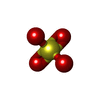登録情報 データベース : PDB / ID : 8g4kタイトル Complex of TbRII mini protein binder bound to the TbRII ECD 5HCS_TGFBR2_1 TGF-beta receptor type-2 キーワード / / / / 機能・相同性 分子機能 ドメイン・相同性 構成要素
/ / / / / / / / / / / / / / / / / / / / / / / / / / / / / / / / / / / / / / / / / / / / / / / / / / / / / / / / / / / / / / / / / / / / / / / / / / / / / / / / / / / / / / / / / / / / / / / / / / / / / / / / / / / / / / / / / / / / / / / / / / / / / / / / / / / 生物種 synthetic construct (人工物) Homo sapiens (ヒト)手法 / / / 解像度 : 1.24 Å データ登録者 Schwartze, T.S. / Hinck, A.P. 資金援助 組織 認可番号 国 National Institutes of Health/National Institute of General Medical Sciences (NIH/NIGMS) GM58670-01 National Institutes of Health/National Cancer Institute (NIH/NCI) CA233622
ジャーナル : Nat Commun / 年 : 2025タイトル : Design of high-affinity binders to immune modulating receptors for cancer immunotherapy.著者: Yang, W. / Hicks, D.R. / Ghosh, A. / Schwartze, T.A. / Conventry, B. / Goreshnik, I. / Allen, A. / Halabiya, S.F. / Kim, C.J. / Hinck, C.S. / Lee, D.S. / Bera, A.K. / Li, Z. / Wang, Y. / ... 著者 : Yang, W. / Hicks, D.R. / Ghosh, A. / Schwartze, T.A. / Conventry, B. / Goreshnik, I. / Allen, A. / Halabiya, S.F. / Kim, C.J. / Hinck, C.S. / Lee, D.S. / Bera, A.K. / Li, Z. / Wang, Y. / Schlichthaerle, T. / Cao, L. / Huang, B. / Garrett, S. / Gerben, S.R. / Rettie, S. / Heine, P. / Murray, A. / Edman, N. / Carter, L. / Stewart, L. / Almo, S.C. / Hinck, A.P. / Baker, D. 履歴 登録 2023年2月9日 登録サイト / 処理サイト 改定 1.0 2024年8月14日 Provider / タイプ 改定 1.1 2024年10月9日 Group カテゴリ / pdbx_modification_featureItem 改定 1.2 2025年9月3日 Group / カテゴリ / citation_authorItem _citation.country / _citation.journal_abbrev ... _citation.country / _citation.journal_abbrev / _citation.journal_id_CSD / _citation.journal_id_ISSN / _citation.journal_volume / _citation.page_first / _citation.page_last / _citation.pdbx_database_id_DOI / _citation.pdbx_database_id_PubMed / _citation.title / _citation.year / _citation_author.identifier_ORCID / _citation_author.name
すべて表示 表示を減らす
 データを開く
データを開く 基本情報
基本情報 要素
要素 キーワード
キーワード 機能・相同性情報
機能・相同性情報 Homo sapiens (ヒト)
Homo sapiens (ヒト) X線回折 /
X線回折 /  シンクロトロン /
シンクロトロン /  分子置換 / 解像度: 1.24 Å
分子置換 / 解像度: 1.24 Å  データ登録者
データ登録者 米国, 2件
米国, 2件  引用
引用 ジャーナル: Nat Commun / 年: 2025
ジャーナル: Nat Commun / 年: 2025 構造の表示
構造の表示 Molmil
Molmil Jmol/JSmol
Jmol/JSmol ダウンロードとリンク
ダウンロードとリンク ダウンロード
ダウンロード 8g4k.cif.gz
8g4k.cif.gz PDBx/mmCIF形式
PDBx/mmCIF形式 pdb8g4k.ent.gz
pdb8g4k.ent.gz PDB形式
PDB形式 8g4k.json.gz
8g4k.json.gz PDBx/mmJSON形式
PDBx/mmJSON形式 その他のダウンロード
その他のダウンロード 8g4k_validation.pdf.gz
8g4k_validation.pdf.gz wwPDB検証レポート
wwPDB検証レポート 8g4k_full_validation.pdf.gz
8g4k_full_validation.pdf.gz 8g4k_validation.xml.gz
8g4k_validation.xml.gz 8g4k_validation.cif.gz
8g4k_validation.cif.gz https://data.pdbj.org/pub/pdb/validation_reports/g4/8g4k
https://data.pdbj.org/pub/pdb/validation_reports/g4/8g4k ftp://data.pdbj.org/pub/pdb/validation_reports/g4/8g4k
ftp://data.pdbj.org/pub/pdb/validation_reports/g4/8g4k
 F&H 検索
F&H 検索 リンク
リンク 集合体
集合体
 要素
要素
 Homo sapiens (ヒト) / 遺伝子: TGFBR2 / プラスミド: pET32a / 発現宿主:
Homo sapiens (ヒト) / 遺伝子: TGFBR2 / プラスミド: pET32a / 発現宿主: 
 X線回折 / 使用した結晶の数: 1
X線回折 / 使用した結晶の数: 1  試料調製
試料調製 シンクロトロン / サイト:
シンクロトロン / サイト:  APS
APS  / ビームライン: 22-ID / 波長: 1 Å
/ ビームライン: 22-ID / 波長: 1 Å 解析
解析 分子置換
分子置換 ムービー
ムービー コントローラー
コントローラー



 PDBj
PDBj






